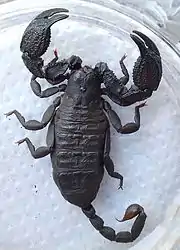Opisthacanthus capensis
Opisthacanthus capensis (Thorell, 1876) is a Cape Province and Zimbabwean species of scorpion with robust chelae, dark brown to black in colour, turning green when under cover for some time. Opisthacanthus is arboreal and ground-dwelling, and found mainly in moist habitats in dense vegetation, pine plantations and forests, hiding under bark and rocks. There are 32 species and subspecies in this genus, all occurring in Southern Africa.[2]
| Opisthacanthus capensis | |
|---|---|
 | |
| Opisthacanthus capensis by Johann Friedrich Wilhelm Herbst | |
 | |
| Scientific classification | |
| Kingdom: | |
| Phylum: | |
| Class: | |
| Order: | |
| Family: | Hemiscorpiidae (Liochelidae) |
| Genus: | |
| Species: | O. capensis |
| Binomial name | |
| Opisthacanthus capensis Thorell, 1876 | |
| Synonyms | |
| |
Its venom contains powerful neurotoxins and cytotoxins, including mucopolysaccharides, hyaluronidases, phospholipases, serotonins, histamines, enzyme inhibitors, and proteins such as neurotoxic peptides. The venom from O. capensis is largely composed of melittin which stimulates the release of the enzyme phospholipase A2 causing inflammation and pain. Phospholipase A2 cleaves the SN-2 acyl chain, releasing arachidonic acid.
This species features in the diets of the bat-eared fox Otocyon megalotis (Canidae), the yellow mongoose Cynictis penicillata, the small grey mongoose Galerella pulverulenta, and the water mongoose Atilax paludinosus (Viverridae).[3]
References
- "Opisthacanthus capensis Thorell, 1876". www.gbif.org.
- http://insectoid.info/arachnida/dromopoda/scorpiones/liochelidae/liochelinae/opisthacanthus/nepabellus/capensis/
- "Comparative diets of sympatric small carnivores" (PDF). South African Journal of Wildlife Research. hdl:10520/AJA03794369_3577. ISSN 2410-7220.
External links
| Wikimedia Commons has media related to Opisthacanthus capensis. |